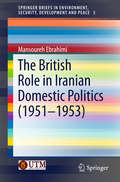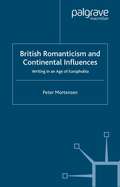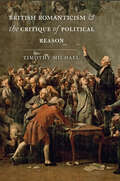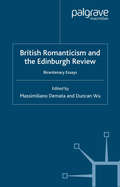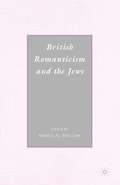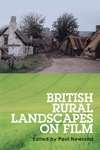- Table View
- List View
British representations of the Spanish Civil War
by Brian ShelmerdineThis book looks at the reception of the Spanish Civil War in British popular culture, and how supporters of both sides in Britain used the rhetoric and imagery of the conflict to bolster support for their respective causes in the arena of British public opinion. Brian Shelmerdine finds that traditional notions of Spain as a country of bullfighting, bandits and flamenco were pervasive and were significant in shaping wider UK government policy towards Spain. He carefully assesses the different political perceptions of the 1930s Spanish scene, the role of the Catholic Church, the depiction of the two sides in terms of class, race and ethnicity, humanitarian appeals, and the plight of the Basques. The book is fluently written, and should make fascinating and entertaining reading for scholars of British society and culture in the twentieth century, as well as those investigating international impact of the Spanish Civil War.
British Republic, 1649-60 (British History in Perspective)
by Ronald HuttonThis book represents a synthesis of all the most recent research into this important period, in an accessible form and at an accessible price. It reconsiders some of the most colourful and celebrated episodes in the history of the British Isles, and some of the most remarkable characters. It considers diplomatic, military, political, religious, intellectual, and social developments. It covers Ireland and Scotland as well as England and Wales, and treats issues at a provincial level as thoroughly as those upon the national scene. Repeatedly, the author provides his own provocative solutions to questions as well as presenting the work of his colleagues. Thus, it is both a collective and a personal portrait of an age. It ought to meet the needs of students at all levels, as well as entertaining the general reader.
British Responses to Genocide: The British Foreign Office and Humanitarianism in the Ottoman Empire, 1918-1923 (Routledge Studies in Modern British History)
by Amy E. Grubb Elisabeth Hope MurrayThis book examines British responses to genocide and atrocity in the Ottoman Empire during the aftermath of World War I. The authors analyze British humanitarianism and humanitarian intervention through the advice and policies of the Foreign Office and British government in London and the actions of Foreign Officers in the field. British understandings of humanitarianism at the time revolved around three key elements: good government, atrocity, and the refugee crises; this ideology of humanitarianism, however, was challenged by disputed policies of post-war politics and goals regarding the Near East. This resulted in limited intervention methods available to those on the ground but did not necessarily result in the forfeiture of the belief in humanitarianism amongst the local British officials charged with upholding it. This study shows that the tension between altruism and political gain weakened British power in the region, influencing the continuation of violence and repression long after the date most perceive as the cessation of WWI. The book is primarily aimed at scholars and researchers within the field; it is a research monograph and will be of greatest interest to scholars of genocide, British history, and refugee studies, as well as for activists and practitioners.
British Responses to Genocide: The British Foreign Office and Humanitarianism in the Ottoman Empire, 1918-1923 (Routledge Studies in Modern British History)
by Amy E. Grubb Elisabeth Hope MurrayThis book examines British responses to genocide and atrocity in the Ottoman Empire during the aftermath of World War I. The authors analyze British humanitarianism and humanitarian intervention through the advice and policies of the Foreign Office and British government in London and the actions of Foreign Officers in the field. British understandings of humanitarianism at the time revolved around three key elements: good government, atrocity, and the refugee crises; this ideology of humanitarianism, however, was challenged by disputed policies of post-war politics and goals regarding the Near East. This resulted in limited intervention methods available to those on the ground but did not necessarily result in the forfeiture of the belief in humanitarianism amongst the local British officials charged with upholding it. This study shows that the tension between altruism and political gain weakened British power in the region, influencing the continuation of violence and repression long after the date most perceive as the cessation of WWI. The book is primarily aimed at scholars and researchers within the field; it is a research monograph and will be of greatest interest to scholars of genocide, British history, and refugee studies, as well as for activists and practitioners.
A British Rifleman - the Journals and Correspondence of Major George Simmons, Rifle Brigade, during the Peninsular war and the campaign of Waterloo
by Lt.-Colonel Willoughby Cole Verner Major SimmonsThe journals and correspondence of George Simmons add a further lustre to the excellent memoirs and books that men of the 95th Rifles left of the adventures, hard fought actions and grim experiences of the Peninsular War and the Waterloo Campaign. Simmons was commissioned into the 1st Battalion 95th Rifles, a fellow officer of Sir John Kincaid and Sir Harry Smith both of whom left valuable memoirs of the period. A religious and upright man, although not priggish, he kept a journal of the actions movement and events of his life and sent numerous letters home to his family in Hull. These form the narrative which has been ordered by Lt. Col. Verner to flow in sequence through his time fighting Napoleon’s forces.Simmons, and his brothers who often crop up in the volume, was at the forefront of the fighting engaged in by the Light Brigade and later Light Division. He was wounded a number of times, once so seriously at Waterloo as a result of a musket wound to the chest, that his attendants though he might die. He took part in the battles of Fuentes D’Oñoro, Salamanca, Vittoria, the Nivelle, Orthez and finally Waterloo. The storming of Badajoz, Cuidad Rodrigo are also described in vivid detail missing nothing of the fear, death and mayhem of the attacking troops; to give just one excerpt of the action:- I saw my poor friend Major O'Hare lying dead upon the breach. Two or three musket balls had passed through his breast. A gallant fellow, Sergeant Flemming, was also dead by his side, a man who had always been with him. I called to remembrance poor O'Hare's last words just before he marched off to lead the advance. He shook me by the hand saying, "A Lieutenant-Colonel or cold meat in a few hours." I was now gazing upon his body lying stretched and naked amongst thousands more.An excellent read, contemporaneously written and abounding with interesting details.Author – Major George Simmons [1785-1858]Editor – Lt.-Col Willoughby Cole Verner [1852-1922]
British Rifleman vs French Skirmisher: Peninsular War and Waterloo 1808–15 (Combat #46)
by David GreentreeThe battles between British and French forces during the Peninsular War (1807–14) and the Hundred Days campaign of 1815 saw both sides deploy specialist units of skirmishers trained in marksmanship and open-order combat. These 'light' troops fulfilled several important roles on the battlefield, such as 'masking' large bodies of close-order troops as they manoeuvred in battle, firing upon enemy troops to provoke them into attacking prematurely, and harassing enemy artillery crews and senior officers with aimed fire. On occasion, the skirmishers were tasked with special missions requiring individual initiative, such as the capture or defence of key battlefield positions, especially those situated in difficult terrain. While Napoleon's skirmishers carried the smoothbore musket, notoriously inaccurate and short-ranged, several elite units fighting for Britain were armed with the rifle, a far more accurate weapon that was hampered by a slower rate of fire. As well as the legendary 95th Rifles, Britain fielded rifle-armed German troops of the 60th Regiment and the King's German Legion, while France's light troops were fielded in individual companies but also entire regiments. In this study, David Greentree assesses the role and effectiveness of rifle-armed British troops and their French open-order opponents in three very different encounters: Roliça (August 1808), the first British battle of the Peninsular War; the struggle for a key bridge at Barba del Puerco (March 1810); and the bitter fight for the La Haye Sainte farmhouse during the battle of Waterloo (June 1815).
British Rifleman vs French Skirmisher: Peninsular War and Waterloo 1808–15 (Combat)
by David GreentreeThe battles between British and French forces during the Peninsular War (1807–14) and the Hundred Days campaign of 1815 saw both sides deploy specialist units of skirmishers trained in marksmanship and open-order combat. These 'light' troops fulfilled several important roles on the battlefield, such as 'masking' large bodies of close-order troops as they manoeuvred in battle, firing upon enemy troops to provoke them into attacking prematurely, and harassing enemy artillery crews and senior officers with aimed fire. On occasion, the skirmishers were tasked with special missions requiring individual initiative, such as the capture or defence of key battlefield positions, especially those situated in difficult terrain. While Napoleon's skirmishers carried the smoothbore musket, notoriously inaccurate and short-ranged, several elite units fighting for Britain were armed with the rifle, a far more accurate weapon that was hampered by a slower rate of fire. As well as the legendary 95th Rifles, Britain fielded rifle-armed German troops of the 60th Regiment and the King's German Legion, while France's light troops were fielded in individual companies but also entire regiments. In this study, David Greentree assesses the role and effectiveness of rifle-armed British troops and their French open-order opponents in three very different encounters: Roliça (August 1808), the first British battle of the Peninsular War; the struggle for a key bridge at Barba del Puerco (March 1810); and the bitter fight for the La Haye Sainte farmhouse during the battle of Waterloo (June 1815).
The British Role in Iranian Domestic Politics (SpringerBriefs in Environment, Security, Development and Peace #5)
by Mansoureh EbrahimiBased on British and Iranian sources, this book investigates the background and goals of the coup in Iran, examining how British foreign and domestic agents interfered with Iran’s internal affairs between the nationalization of Iran’s oil in 1951 until its failure in 1953 with the overthrow of Prime Minister Mossadegh. How and why was Iran’s democratically elected government ousted in 1953? Most studies refer to a ‘CIA-led’ operation. This study analyses how British agents used the Shah, the ancient Persian Durbar, Majlis deputies, Islamic clergy, and Iranian military officers in the overthrow of the first democratically elected Prime Minister, and highlights how Britain used the ‘Communist menace’ as a pretext for protecting its oil interests and persuaded the Americans to orchestrate the coup. This close interaction between British colonial interests, American Cold War goals and Iranian politics ultimately defeated the democratic aspirations of Iran’s people.
British Romantic Literature and the Emerging Modern Greek Nation (Palgrave Studies In The Enlightenment, Romanticism And Cultures Of Print Ser.)
by Alexander GrammatikosBritish Romantic Literature and the Emerging Modern Greek Nation makes an original contribution to the field of British Romantic Hellenism (and Romanticism more broadly) by emphasizing the diversity of Romantic-era writers’ attitudes towards, and portrayals of, Modern Greece. Whereas, traditionally, studies of British Romantic Hellenism have predominantly focused on Europe’s preoccupation with an idealized Ancient Greece, this study emphasizes the nuanced and complex nature of British Romantic writers’ engagements with Modern Greece. Specifically, the book emphasizes the ways that early nineteenth-century British literature about contemporary Greece helped to strengthen British-Greek intercultural relations and, ultimately, to situate Greece within a European sphere of influence.
British Romanticism and Continental Influences: Writing in an Age of Europhobia
by P. MortensenDuring the 1790s and 1800s, cultural critics became convinced that Britain was being 'inundated' by pernicious literary translations imported from the European Continent. British Romanticism and Continental Influences discusses Romantic writers' complex and ambivalent responses to this threatening literary invasion. Confronted with foreign texts that seemed both attractive and repulsive, Mortensen argues, Romantic writers such as Wordsworth and Coleridge publicly distanced themselves from European sensationalism, even as they assimilated and revised its conventions in their own writing.
British Romanticism and the Critique of Political Reason
by Timothy MichaelWhat role should reason play in the creation of a free and just society? Can we claim to know anything in a field as complex as politics? And how can the cause of political rationalism be advanced when it is seen as having blood on its hands? These are the questions that occupied a group of British poets, philosophers, and polemicists in the years following the French Revolution.Timothy Michael argues that much literature of the period is a trial, or a critique, of reason in its political capacities and a test of the kinds of knowledge available to it. For Wordsworth, Coleridge, Shelley, Burke, Wollstonecraft, and Godwin, the historical sequence of revolution, counter-revolution, and terror in Franceâ€�and radicalism and repression in Britainâ€�occasioned a dramatic reassessment of how best to advance the project of enlightenment. The political thought of these figures must be understood, Michael contends, in the context of their philosophical thought. Major poems of the period, including The Prelude, The Excursion, and Prometheus Unbound, are in this reading an adjudication of competing political and epistemological claims. This book bridges for the first time two traditional pillars of Romantic studies: the period’s politics and its theories of the mind and knowledge. Combining literary and intellectual history, it provides an account of British Romanticism in which high rhetoric, political prose, poetry, and poetics converge in a discourse of enlightenment and emancipation.
British Romanticism and the Edinburgh Review: Bicentenary Essays
by M. Demata D. WuThe bicentenary of the foundation of the Edinburgh Review has provided the foremost scholars in the field with the opportunity to re-examine the pervasive significance of the most important literary review of the Romantic period. These essays assess the controversial role played by the Edinburgh Review in the development of Romantic literature and explore its sense of 'Scottishness' in the context of early nineteenth-century British culture.
British Romanticism and the Jews: History, Culture, Literature
by S. SpectorBritish Romanticism and the Jews explores the mutual influences exerted by the British-Christian and British-Jewish communities on each other during the period between the Enlightenment and Victorianism. The essays in the volume demonstrate how the texts produced by the Jewish Enlightenment provided a significant resource for romantic intellectual revisionism, in much the same way that British romanticism provided the cultural basis through which the British-Jewish community was able to negotiate between the competing obligations to ethnicity and nationalism.
British Romanticism and the Reception of Italian Old Master Art, 1793-1840 (Studies in Art Historiography)
by Maureen McCueAs a result of Napoleon’s campaigns in Italy, Old Master art flooded into Britain and its acquisition became an index of national prestige. Maureen McCue argues that their responses to these works informed the writing of Romantic period authors, enabling them to forge often surprising connections between Italian art, the imagination and the period’s political, social and commercial realities. Dr McCue examines poetry, plays, novels, travel writing, exhibition catalogues, early guidebooks and private experiences recorded in letters and diaries by canonical and noncanonical authors, including Felicia Hemans, William Buchanan, Henry Sass, Pierce Egan, William Hazlitt, Percy Shelley, Lord Byron, Anna Jameson, Maria Graham Callcott and Samuel Rogers. Her exploration of the idea of connoisseurship shows the ways in which a knowledge of Italian art became a key marker of cultural standing that was no longer limited to artists and aristocrats, while her chapter on the literary production of post-Waterloo Britain traces the development of a critical vocabulary equally applicable to the visual arts and literature. In offering cultural, historical and literary readings of the responses to Italian art by early nineteenth-century writers, Dr McCue illuminates the important role they played in shaping the themes that are central to our understanding of Romanticism.
British Romanticism and the Reception of Italian Old Master Art, 1793-1840 (Studies in Art Historiography)
by Maureen McCueAs a result of Napoleon’s campaigns in Italy, Old Master art flooded into Britain and its acquisition became an index of national prestige. Maureen McCue argues that their responses to these works informed the writing of Romantic period authors, enabling them to forge often surprising connections between Italian art, the imagination and the period’s political, social and commercial realities. Dr McCue examines poetry, plays, novels, travel writing, exhibition catalogues, early guidebooks and private experiences recorded in letters and diaries by canonical and noncanonical authors, including Felicia Hemans, William Buchanan, Henry Sass, Pierce Egan, William Hazlitt, Percy Shelley, Lord Byron, Anna Jameson, Maria Graham Callcott and Samuel Rogers. Her exploration of the idea of connoisseurship shows the ways in which a knowledge of Italian art became a key marker of cultural standing that was no longer limited to artists and aristocrats, while her chapter on the literary production of post-Waterloo Britain traces the development of a critical vocabulary equally applicable to the visual arts and literature. In offering cultural, historical and literary readings of the responses to Italian art by early nineteenth-century writers, Dr McCue illuminates the important role they played in shaping the themes that are central to our understanding of Romanticism.
British Romanticism, Climate Change, and the Anthropocene: Writing Tambora
by David HigginsThis book is the first major ecocritical study of the relationship between British Romanticism and climate change. It analyses a wide range of texts – by authors including Lord Byron, William Cobbett, Sir Stamford Raffles, Mary Shelley, and Percy Shelley – in relation to the global crisis produced by the eruption of Mount Tambora in 1815. By connecting these texts to current debates in the environmental humanities, it reveals the value of a historicized approach to the Anthropocene. British Romanticism, Climate Change, and the Anthropocene examines how Romantic texts affirm the human capacity to shape and make sense of a world with which we are profoundly entangled and at the same time represent our humiliation by powerful elemental forces that we do not fully comprehend. It will appeal not only to scholars of British Romanticism, but to anyone interested in the relationship between culture and climate change.
British Romanticism, Climate Change, and the Anthropocene: Writing Tambora
by David HigginsThis book is the first major ecocritical study of the relationship between British Romanticism and climate change. It analyses a wide range of texts – by authors including Lord Byron, William Cobbett, Sir Stamford Raffles, Mary Shelley, and Percy Shelley – in relation to the global crisis produced by the eruption of Mount Tambora in 1815. By connecting these texts to current debates in the environmental humanities, it reveals the value of a historicized approach to the Anthropocene. British Romanticism, Climate Change, and the Anthropocene examines how Romantic texts affirm the human capacity to shape and make sense of a world with which we are profoundly entangled and at the same time represent our humiliation by powerful elemental forces that we do not fully comprehend. It will appeal not only to scholars of British Romanticism, but to anyone interested in the relationship between culture and climate change.
British Romanticism, Climate Change, and the Anthropocene: Writing Tambora
by David HigginsThis book is the first major ecocritical study of the relationship between British Romanticism and climate change. It analyses a wide range of texts – by authors including Lord Byron, William Cobbett, Sir Stamford Raffles, Mary Shelley, and Percy Shelley – in relation to the global crisis produced by the eruption of Mount Tambora in 1815. By connecting these texts to current debates in the environmental humanities, it reveals the value of a historicized approach to the Anthropocene. British Romanticism, Climate Change, and the Anthropocene examines how Romantic texts affirm the human capacity to shape and make sense of a world with which we are profoundly entangled and at the same time represent our humiliation by powerful elemental forces that we do not fully comprehend. It will appeal not only to scholars of British Romanticism, but to anyone interested in the relationship between culture and climate change.
British Romanticism in European Perspective: Into the Eurozone
by Sean RyanWhat, and when, is British Romanticism, if seen not in island isolation but cosmopolitan integration with European Romantic literature, history and culture? The essays here range from poetry and the novel to science writing, philosophy, visual art, opera and melodrama; from France and Germany to Italy and Bosnia.
British Routes to India. (Routledge Revivals)
by Halford Lancaster HoskinsFirst published in 1928, this volume examines the routes to India which originated as a means of communication and casual trading voyages in the late 18th century but which evolved under European imperialism, adding vast significance and definite lines of access alongside economic and social uses in times of peace, strategic access in times of war and acting as political objects on all occasions. Halford Lancaster Hoskins responded to the solicitude of the Powers of Europe in relation to countries in the eastern Mediterranean, which had been a conspicuous feature of international relations since the rise of the Eastern Question.
British Routes to India. (Routledge Revivals)
by Halford Lancaster HoskinsFirst published in 1928, this volume examines the routes to India which originated as a means of communication and casual trading voyages in the late 18th century but which evolved under European imperialism, adding vast significance and definite lines of access alongside economic and social uses in times of peace, strategic access in times of war and acting as political objects on all occasions. Halford Lancaster Hoskins responded to the solicitude of the Powers of Europe in relation to countries in the eastern Mediterranean, which had been a conspicuous feature of international relations since the rise of the Eastern Question.
British rural landscapes on film
by Paul NewlandBritish rural landscapes on film offers insights into how rural areas in Britain have been represented on film, from the silent era, through both world wars, and on into the twenty-first century. It is the first book to exclusively deal with representations of the British countryside on film. The contributors demonstrate that the countryside has provided Britain (and its constituent nations and regions) with a dense range of spaces in which cultural identities have been (and continue to be) worked through. British rural landscapes on film demonstrates that British cinema provides numerous examples of how national identity and the identity of the countryside have been partly constructed through filmic representation, and how British rural films can allow us to further understand the relationship between the cultural identities of specific areas of Britain and the landscapes they inhabit.
British rural landscapes on film (PDF)
by Paul NewlandBritish rural landscapes on film offers insights into how rural areas in Britain have been represented on film, from the silent era, through both world wars, and on into the twenty-first century. It is the first book to exclusively deal with representations of the British countryside on film. The contributors demonstrate that the countryside has provided Britain (and its constituent nations and regions) with a dense range of spaces in which cultural identities have been (and continue to be) worked through. British rural landscapes on film demonstrates that British cinema provides numerous examples of how national identity and the identity of the countryside have been partly constructed through filmic representation, and how British rural films can allow us to further understand the relationship between the cultural identities of specific areas of Britain and the landscapes they inhabit.
The British Sailor of the First World War (Shire Library)
by Quintin ColvilleIn 1914 Great Britain had the largest and most powerful navy the world had ever seen – a well-known fact, but what of the everyday experience of those who served in her? This fully illustrated book looks at the British sailor's life during the First World War, from the Falkland Islands to the East African coast to the North Sea. Meals in the stokers' mess and the admiral's cabin; the claustrophobic terrors of the engine room or submarine; the long separations from loved ones that were the shared experience of all ranks; the perils faced by Royal Naval Air Service pilots in the air; the possessions treasured by sailors while at sea – drawing on a wealth of previously unpublished materials from the National Maritime Museum archives, this is an authoritative and vivid account of lives lived in quite extraordinary circumstances.
The British Sailor of the First World War (Shire Library)
by Quintin ColvilleIn 1914 Great Britain had the largest and most powerful navy the world had ever seen – a well-known fact, but what of the everyday experience of those who served in her? This fully illustrated book looks at the British sailor's life during the First World War, from the Falkland Islands to the East African coast to the North Sea. Meals in the stokers' mess and the admiral's cabin; the claustrophobic terrors of the engine room or submarine; the long separations from loved ones that were the shared experience of all ranks; the perils faced by Royal Naval Air Service pilots in the air; the possessions treasured by sailors while at sea – drawing on a wealth of previously unpublished materials from the National Maritime Museum archives, this is an authoritative and vivid account of lives lived in quite extraordinary circumstances.





